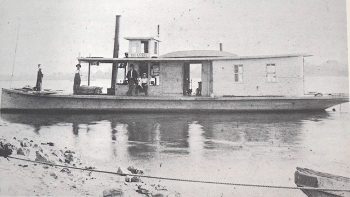
By Lee Epps

Photo courtesy of the Houston County Historical Society
Second of a series
Before there were bridges, there was a great variety of boats on the Mississippi River, including steam-powered vessels. As early as 1855, Job Brown, the founder of Brownsville and Riceford, owned the “H. M. Rice“ (like Riceford, named for early Minnesota politician Henry Mower Rice.) By 1863, there was a need for packet boat service to transport people and goods between Brownsville and La Crosse. Early that spring, the steamer “Spray” was in service for three months before replaced by the “Express,” owned and operated by Captain George Leonard Winslow. He and/or his eldest son would ply those waters for decades.
George (1824-1908), born in Denham, Mass., learned his trade from his father and for a time, worked as a machinist at the Charlestown Navy Yard. While Job Brown was settling along the Mississippi River in 1849, Winslow and some associates purchased the ship “Areatas” and took it around Cape Horn at the tip of South America and back up to California before returning across the Isthmus of Panama in 1853. Later that year, he married Luella Morse in New Hampshire; their first child was born in 1855. By 1863, he had moved to La Crosse and was associated with the steamboat business.
Captain Winslow and the “Express” went back and forth between Brownsville and La Crosse for 10 years. During that time, in 1868 or ‘69, the captain and the “Express” also made three trips from La Crosse to Black River Falls, purportedly the only steamboat to make that trip.
When the “Express” became unseaworthy, Winslow built the “Vigor” in 1872 as a replacement. About this time, a railroad company offered competition with the steamer “Gussie Girdon,” prompting Winslow and his vessel to engage in other business down the river. But about two years later, when the railroad abandoned their service, Winslow returned to the Brownsville-to-La Crosse route where he remained until retiring in 1898 – 35 years after becoming a pioneer of area river transportation.
Captain Winslow also built the “White Beaver” and the “Beaver.” His son, Edward Marcellus Winslow (1855-1935), became well-known for being the skipper of the “White Beaver.” Born in Massachusetts like his father, Edward relocated as a youth with the family to La Crosse where he became captivated by the river. And likely with the family, he made the move across the river into Minnesota. Edward lived in Brownsville when he, at age 27, married Amelia Brenner there in 1882.
Upon his death in 1935, a published tribute eloquently described how Edward, like his father George, had followed his passion while playing a prominent role on the river and witnessing its history. It ends with a reference to the song, “Ol’ Man River” from the 1927 musical Show Boat.
Quoted with original spelling and (mostly the lack of) punctuation:
“Captain Edward Marcellus Winslow has tied up at the levee for the last time and gone down the gang plank to turn in his log book and ship’s papers over to the Great Skipper. If you could finger the pages of the captain’s log you would discover a man’s great love for the river. For over sixty years he lived either upon it or near its banks. As a youth he boarded his first steamer as a boat-hand to help with the task of floating the commerce of the growing empire of the middlewest. From the river steamer’s deck he watched civilization come to the wilderness, watched cities and towns build back from the water front, watched the timbered lands between the bluffs on the upper river transformed into acres of grain, watched the lumber for a nation floated down from the north, watched the river reach the pinnacle of importance, watched it fade in significance as the railroads bridged the channel and penetrated into the western territory. The captain’s life story is very much the story of the upper Mississippi. Strong in youth, years of thrilling adventure and romance. Middle age, a well regulated, prosperous business. Old age, just rolling along toward the delta. The captain leaves the river. His craft is at the levee, the light in the pilot house extinguished and upon a hillside he rests where his spirit watches the river “just keep rollin’ along.”


Leave a Reply